Heat engines and refrigerators
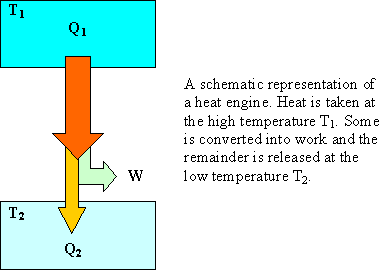 To convert heat into work, you need at least two places
with different temperatures. If you take in Qhigh at
temperature Thigh you must dump at least Qlow at
temperature Tlow. The amount of work you get out of a
heat engine is W = Qhigh - Qlow. The maximum amount of work you can get out of a
heat engine is the amount you get
out of a reversible engine.
To convert heat into work, you need at least two places
with different temperatures. If you take in Qhigh at
temperature Thigh you must dump at least Qlow at
temperature Tlow. The amount of work you get out of a
heat engine is W = Qhigh - Qlow. The maximum amount of work you can get out of a
heat engine is the amount you get
out of a reversible engine.
Wmax = (Qhigh - Qlow)reversible
= Qhigh - QhighTlow/Thigh
= Qhigh(1 - Tlow/Thigh).
W is positive if Thigh is greater than Tlow.
The efficiency of a heat engine
is the ratio of the work obtained to the heat energy put in at the high
temperature, e = W/Qhigh. The maximum possible
efficiency emax of such an engine is
emax = Wmax/Qhigh = (1 - Tlow
/Thigh) = (Thigh - Tlow)/Thigh.
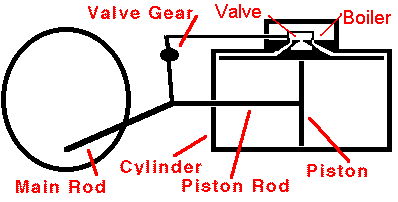 Steam engines
Steam engines
A steam engine is a type of heat engine. It takes heat from the
hot steam, converts some of this heat into useful work and dumps the
rest into the colder surrounding air. The maximum fraction of heat
that can be converted into work can be found using the laws of
thermodynamics, and it increases with the temperature difference between
the hot steam and the surrounding air. The hotter the steam and
the colder the air, the more efficient is the steam engine at converting
heat into work.
In a typical steam engine a piston moves back and forth inside a
cylinder. Hot, high-pressure steam is produced in a boiler, and
this steam enters the cylinder through a valve. Once inside the
cylinder, the steam pushes outward on every surface, including the
piston. The piston moves. The steam does mechanical work on
the piston and the piston does mechanical work on the machinery attached
to it. The expanding steam transfers some of its thermal energy to
this machinery, so the steam becomes cooler as the machinery operates.
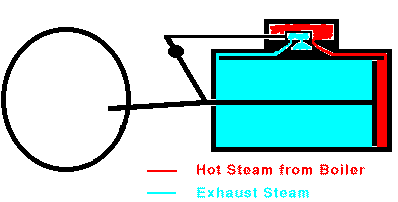 When the piston reaches the end of its range, the valve stops the
flow of steam and opens the cylinder to the outside air. The
piston can then return easily. In many cases, steam is allowed to
enter the other end of the cylinder so that the steam pushes the piston
back to its original position. Once the piston is back at its
starting point, the valve again admits high-pressure steam to the
cylinder and the whole cycle repeats. Overall, heat is flowing
from the hot boiler to the cooler surrounding air and some of that heat
is being converted into mechanical work by the moving piston. The
maximum efficiency of a steam engine is emax = (Tsteam
- Tair)/Tsteam. The actual efficiency
is usually much lower.
When the piston reaches the end of its range, the valve stops the
flow of steam and opens the cylinder to the outside air. The
piston can then return easily. In many cases, steam is allowed to
enter the other end of the cylinder so that the steam pushes the piston
back to its original position. Once the piston is back at its
starting point, the valve again admits high-pressure steam to the
cylinder and the whole cycle repeats. Overall, heat is flowing
from the hot boiler to the cooler surrounding air and some of that heat
is being converted into mechanical work by the moving piston. The
maximum efficiency of a steam engine is emax = (Tsteam
- Tair)/Tsteam. The actual efficiency
is usually much lower.
External link: Steam locomotive (Youtube)
Problem:
What is the maximum
possible efficiency of a steam engine taking in heat at 100 oC
and dumping it at room temperature of approximately 20 oC?
Solution:
- Reasoning:
The maximum efficiency of any heat engine is that of a Carnot engine. emax = (Thigh - Tlow)/Thigh.
- Details of the calculation:
100 oC = 373 K and 20
oC = 293 K. The
maximum possible efficiency is
(Thigh - Tlow)/Thigh
= (373 -
293)/373 = 0.21 = 21%.
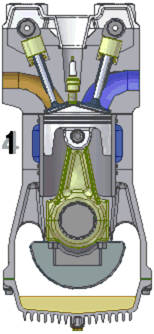 Internal combustion engines
Internal combustion engines
An internal combustion engine burns a mixture of fuel and air.
The most common type is a four-stroke engine. A piston slides in
and out of a cylinder. Two or more valves allow the fuel and the
air to enter the cylinder and the gases that form when the fuel and air
burn to leave the cylinder. As the piston slides back and forth
inside the cylinder, the volume that the gases can occupy changes
drastically.
The process of converting heat into work begins when the piston is
pulled out of the cylinder, expanding the enclosed space and allowing
fuel and air to flow into that space through a valve. This motion
is called the intake stroke or induction stroke. Next, the fuel and
the air mixture are squeezed together by pushing the piston into the
cylinder. This is called the compression
stroke. At the end of the compression stroke, with the
fuel and the air mixture squeezed as tightly as possible, the spark plug
at the sealed end of the cylinder fires and ignites the mixture.
The hot burning fuel has an enormous pressure and it pushes the piston
out of the cylinder. This power stroke is what provides power to the engine and the attached machinery.
Finally, the burned gas is squeezed out of the cylinder through another
valve in the exhaust stroke.
These four strokes repeat over and over again. Most internal
combustion engines have at least four cylinders and pistons. There
is always at least one cylinder going through the power stroke and it
can carry the other cylinders through the non-power strokes. The
maximum efficiency of such an engine is emax = (Tignition
- Tair)/Tignition where Tignition
is the temperature of the fuel-air mixture after ignition. To
maximize the fuel efficiency, you have to create the hottest possible
fuel air mixture after ignition. The highest efficiency that has
been achieved is approximately 50% of emax.
External link: Internal combustion
engine (Youtube)
Problem:
A heat engine absorbs 360 J of thermal energy and performs 25 J of work in
each cycle. Find
(a) the efficiency of the engine and
(b) the thermal energy expelled in each cycle.
Solution:
- Reasoning:
The amount of work you get out of a heat engine is W = Qhigh - Qlow.
The efficiency is e = W/Qhigh.
- Details of the calculation:
Qhigh = 360 J. W = 25 J. Qlow
= Qhigh - W = 335
J.
(a) The efficiency e = W/Qhigh = 6.9%.
(b) The thermal energy expelled is Qlow
= 335 J.
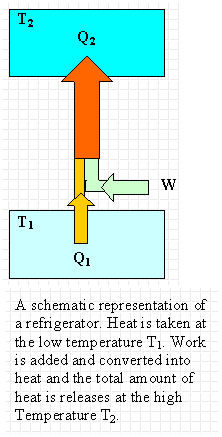 Heat cannot, of itself, flow from a cold to a hot object is one way of stating the second
law of thermodynamics. If it could, then heat dumped at Tlow
could just flow back to the reservoir at Thigh and the net
effect would be an amount of heat ΔQ = Qhigh - Qlow
taken at a Thigh and converted into work with no other
changes in the system.
Heat cannot, of itself, flow from a cold to a hot object is one way of stating the second
law of thermodynamics. If it could, then heat dumped at Tlow
could just flow back to the reservoir at Thigh and the net
effect would be an amount of heat ΔQ = Qhigh - Qlow
taken at a Thigh and converted into work with no other
changes in the system.
Assume you want to take heat from a place at Tlow and dump
it at a place with a higher temperature Thigh. You want
to build a refrigerator or an
air conditioner. For
such a device we define the coefficient of
performance COP as the ratio of the amount of heat removed at
the lower temperature to the work put into the system (i.e. the
engine).
COP = Qlow/(-W) = Qlow/(Qhigh
- Qlow).
The best possible coefficient of performance is
COPmax = Qlow/(Qhigh
- Qlow)max = Qlow/(Qlow(Thigh/Tlow)
- Qlow) = Tlow/(Thigh - Tlow),
if we have a reversible engine moving the heat. For a real
engine Qhigh is bigger than QlowThigh/Tlow,
and the coefficient of performance is smaller.
For a refrigerator keeping an inside temperature of 4 oC =
277 K operating in a room at 22 oC = 299 K the best possible
coefficient of performance is COPmax = 277/(299 - 277) =
12.6. The best possible ratio of the amount of heat removed to the
work done is 12.6. Heat cannot flow from inside an ordinary
refrigerator into the warmer room unless we plug in the electric motor
that does work on the refrigerant.
 An air conditioner is a refrigerator whose inside is the room to be cooled (Troom
= Tlow) and whose outside is the great outdoors (Toutside
= Thigh). An air conditioner uses a material
called a "working fluid" to transfer heat from inside of a room to the
great outdoors. The working fluid is a material which transforms
easily from a gas to a liquid and vice versa over a wide range of
temperatures and pressures. This working fluid moves through the
air conditioner's three main components, the compressor, the
condenser,
and the evaporator in a continuous cycle.
An air conditioner is a refrigerator whose inside is the room to be cooled (Troom
= Tlow) and whose outside is the great outdoors (Toutside
= Thigh). An air conditioner uses a material
called a "working fluid" to transfer heat from inside of a room to the
great outdoors. The working fluid is a material which transforms
easily from a gas to a liquid and vice versa over a wide range of
temperatures and pressures. This working fluid moves through the
air conditioner's three main components, the compressor, the
condenser,
and the evaporator in a continuous cycle.
- The working fluid enters the evaporator inside the room as a
low-pressure liquid at approximately outside air temperature.
- The evaporator is typically a snake-like pipe. The fluid
immediately begins to evaporate and expands into a gas. In doing
so, it uses its thermal energy to separate its molecules from one
another and it becomes very cold. Heat flows from the room into
this cold gas. The working fluid leaves the evaporator as a
low-pressure gas a little below room temperature and heads off toward
the compressor.
- It enters the compressor as a low-pressure gas
roughly at room temperature. The compressor squeezes the molecules
of that gas closer together, increasing the gas's density and pressure.
Since squeezing a gas involves physical work, the compressor transfers
energy to the working fluid and that fluid becomes hotter. The
working fluid leaves the compressor as a high-pressure gas well above
outside air temperature.
- The working fluid then enters the
condenser on the outside, which is typically a snake-like pipe.
Since the fluid is hotter than the surrounding air, heat flows out of
the fluid and into the air. The fluid then begins to condense into
a liquid and it gives up additional thermal energy as it condenses.
This additional thermal energy also flows as heat into the outside air.
The working fluid leaves the condenser as a high-pressure liquid at
roughly outside air temperature. It then flows through a
narrowing in the pipe into the evaporator. When the fluid goes
through the narrowing in the pipe, it's pressure drops and it enters the
evaporator as a low-pressure liquid. The cycle repeats.
Overall, heat is been extracted from the room and delivered to the
outside air. The compressor consumes electric energy during this
process and that energy also becomes thermal energy in the outside air.
The maximum coefficient of such an air conditioner is COPmax
= Troom/(Toutside - Troom).
Refrigerators and heat pumps work on the same principle.
A heat pump is a refrigerator whose
inside is the great outdoors and whose outside is the room to be heated. The
coefficient of performance for a heat pump is the ratio of the energy delivered
at the higher temperature to the work put into the system, COP = Qhigh/(Qhigh
- Qlow). The best possible coefficient of performance is
COPmax(heat pump) = (Qhigh/(Qhigh
- Qlow))max
= Thigh/(Thigh - Tlow) = Troom/(Troom
- Toutside)
If the outside temperature is 41 oF = 5oC = 278 K and
room temperature is 77oF = 25oC = 298K then COPmax
= 298/(298 - 278) = 14.9. However, if the outside temperature drops to 14
oF = -10 oC = 263 K then Emax = 298/(298 - 263) = 8.5.
Note: The coefficient of performance for a refrigerator/air conditioner and
the coefficient of performance of a heat pump are defined differently. We
are always interested in how much work we have to do or how much useful energy
we have to invest to accomplish something. For a refrigerator or air
conditioner we are interested in how efficiently heat is removed from the colder
inside for a given amount of work done. For a heat pump we are interested
in how efficiently heat is delivered to the hotter inside for a given amount of
work done. The coefficient of performance gives us those ratios.
External link: The
refrigeration cycle (Youtube)
Problem:
What is the coefficient of performance of a refrigerator that operates with
Carnot efficiency between temperatures of -3 oC and 27 oC?
Solution:
- Reasoning:
For a refrigerator COPmax
= Tlow/(Thigh - Tlow).
- Details of the calculation:
The best possible coefficient of performance is
COPmax
= Tlow/(Thigh - Tlow) =
270/(300 - 270) = 9.
Problem:
A refrigerator has a coefficient of performance equal to 5. If the
refrigerator absorbs 120 J of thermal energy from a cold reservoir in each
cycle, find
(a) the work done in each cycle and
(b) the thermal energy expelled to the hot reservoir.
Solution:
- Reasoning:
For a refrigerator the coefficient of performance is COP = Qlow/(-W).
- Details of the calculation:
(a) COP = Qlow/(-W). (-W) = Qlow/COP = 120/5 J = 24
J.
The work is done on the system. Ordered (electrical) energy is
converted into thermal energy.
(b) (-W) = 24 J = Qhigh - Qlow. Qhigh
=
24 J + 120 J = 144 J.
Embedded Question 2
The energy output of a heat pump is greater than the energy used to operate
the pump. Why doesn't this statement violate the first law of
thermodynamics?
Discuss this with your fellow students in the discussion forum!
 To convert heat into work, you need at least two places
with different temperatures. If you take in Qhigh at
temperature Thigh you must dump at least Qlow at
temperature Tlow. The amount of work you get out of a
heat engine is W = Qhigh - Qlow. The maximum amount of work you can get out of a
heat engine is the amount you get
out of a reversible engine.
To convert heat into work, you need at least two places
with different temperatures. If you take in Qhigh at
temperature Thigh you must dump at least Qlow at
temperature Tlow. The amount of work you get out of a
heat engine is W = Qhigh - Qlow. The maximum amount of work you can get out of a
heat engine is the amount you get
out of a reversible engine. Steam engines
Steam engines When the piston reaches the end of its range, the valve stops the
flow of steam and opens the cylinder to the outside air. The
piston can then return easily. In many cases, steam is allowed to
enter the other end of the cylinder so that the steam pushes the piston
back to its original position. Once the piston is back at its
starting point, the valve again admits high-pressure steam to the
cylinder and the whole cycle repeats. Overall, heat is flowing
from the hot boiler to the cooler surrounding air and some of that heat
is being converted into mechanical work by the moving piston. The
maximum efficiency of a steam engine is emax = (Tsteam
- Tair)/Tsteam. The actual efficiency
is usually much lower.
When the piston reaches the end of its range, the valve stops the
flow of steam and opens the cylinder to the outside air. The
piston can then return easily. In many cases, steam is allowed to
enter the other end of the cylinder so that the steam pushes the piston
back to its original position. Once the piston is back at its
starting point, the valve again admits high-pressure steam to the
cylinder and the whole cycle repeats. Overall, heat is flowing
from the hot boiler to the cooler surrounding air and some of that heat
is being converted into mechanical work by the moving piston. The
maximum efficiency of a steam engine is emax = (Tsteam
- Tair)/Tsteam. The actual efficiency
is usually much lower. Internal combustion engines
Internal combustion engines Heat cannot, of itself, flow from a cold to a hot object is one way of stating the second
law of thermodynamics. If it could, then heat dumped at Tlow
could just flow back to the reservoir at Thigh and the net
effect would be an amount of heat ΔQ = Qhigh - Qlow
taken at a Thigh and converted into work with no other
changes in the system.
Heat cannot, of itself, flow from a cold to a hot object is one way of stating the second
law of thermodynamics. If it could, then heat dumped at Tlow
could just flow back to the reservoir at Thigh and the net
effect would be an amount of heat ΔQ = Qhigh - Qlow
taken at a Thigh and converted into work with no other
changes in the system. An air conditioner is a refrigerator whose inside is the room to be cooled (Troom
= Tlow) and whose outside is the great outdoors (Toutside
= Thigh). An air conditioner uses a material
called a "working fluid" to transfer heat from inside of a room to the
great outdoors. The working fluid is a material which transforms
easily from a gas to a liquid and vice versa over a wide range of
temperatures and pressures. This working fluid moves through the
air conditioner's three main components, the compressor, the
condenser,
and the evaporator in a continuous cycle.
An air conditioner is a refrigerator whose inside is the room to be cooled (Troom
= Tlow) and whose outside is the great outdoors (Toutside
= Thigh). An air conditioner uses a material
called a "working fluid" to transfer heat from inside of a room to the
great outdoors. The working fluid is a material which transforms
easily from a gas to a liquid and vice versa over a wide range of
temperatures and pressures. This working fluid moves through the
air conditioner's three main components, the compressor, the
condenser,
and the evaporator in a continuous cycle.